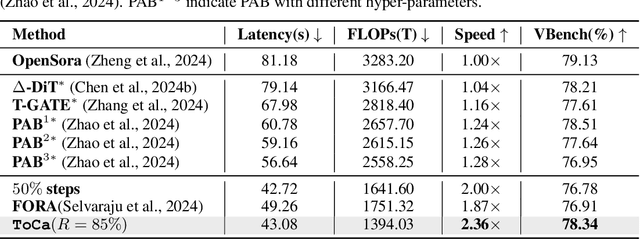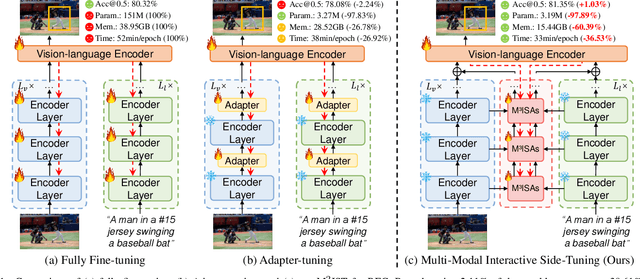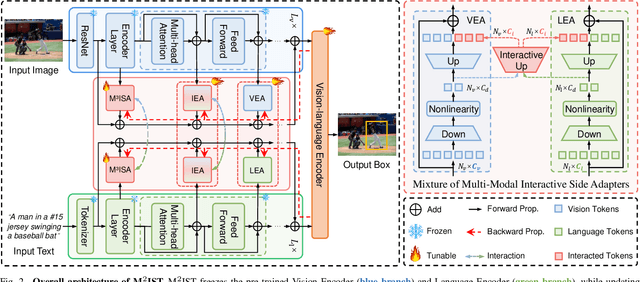Xuyang Liu
AI for Service: Proactive Assistance with AI Glasses
Oct 16, 2025Abstract:In an era where AI is evolving from a passive tool into an active and adaptive companion, we introduce AI for Service (AI4Service), a new paradigm that enables proactive and real-time assistance in daily life. Existing AI services remain largely reactive, responding only to explicit user commands. We argue that a truly intelligent and helpful assistant should be capable of anticipating user needs and taking actions proactively when appropriate. To realize this vision, we propose Alpha-Service, a unified framework that addresses two fundamental challenges: Know When to intervene by detecting service opportunities from egocentric video streams, and Know How to provide both generalized and personalized services. Inspired by the von Neumann computer architecture and based on AI glasses, Alpha-Service consists of five key components: an Input Unit for perception, a Central Processing Unit for task scheduling, an Arithmetic Logic Unit for tool utilization, a Memory Unit for long-term personalization, and an Output Unit for natural human interaction. As an initial exploration, we implement Alpha-Service through a multi-agent system deployed on AI glasses. Case studies, including a real-time Blackjack advisor, a museum tour guide, and a shopping fit assistant, demonstrate its ability to seamlessly perceive the environment, infer user intent, and provide timely and useful assistance without explicit prompts.
Shifting AI Efficiency From Model-Centric to Data-Centric Compression
May 25, 2025Abstract:The rapid advancement of large language models (LLMs) and multi-modal LLMs (MLLMs) has historically relied on model-centric scaling through increasing parameter counts from millions to hundreds of billions to drive performance gains. However, as we approach hardware limits on model size, the dominant computational bottleneck has fundamentally shifted to the quadratic cost of self-attention over long token sequences, now driven by ultra-long text contexts, high-resolution images, and extended videos. In this position paper, \textbf{we argue that the focus of research for efficient AI is shifting from model-centric compression to data-centric compression}. We position token compression as the new frontier, which improves AI efficiency via reducing the number of tokens during model training or inference. Through comprehensive analysis, we first examine recent developments in long-context AI across various domains and establish a unified mathematical framework for existing model efficiency strategies, demonstrating why token compression represents a crucial paradigm shift in addressing long-context overhead. Subsequently, we systematically review the research landscape of token compression, analyzing its fundamental benefits and identifying its compelling advantages across diverse scenarios. Furthermore, we provide an in-depth analysis of current challenges in token compression research and outline promising future directions. Ultimately, our work aims to offer a fresh perspective on AI efficiency, synthesize existing research, and catalyze innovative developments to address the challenges that increasing context lengths pose to the AI community's advancement.
Video Compression Commander: Plug-and-Play Inference Acceleration for Video Large Language Models
May 20, 2025Abstract:Video large language models (VideoLLM) excel at video understanding, but face efficiency challenges due to the quadratic complexity of abundant visual tokens. Our systematic analysis of token compression methods for VideoLLMs reveals two critical issues: (i) overlooking distinctive visual signals across frames, leading to information loss; (ii) suffering from implementation constraints, causing incompatibility with modern architectures or efficient operators. To address these challenges, we distill three design principles for VideoLLM token compression and propose a plug-and-play inference acceleration framework "Video Compression Commander" (VidCom2). By quantifying each frame's uniqueness, VidCom2 adaptively adjusts compression intensity across frames, effectively preserving essential information while reducing redundancy in video sequences. Extensive experiments across various VideoLLMs and benchmarks demonstrate the superior performance and efficiency of our VidCom2. With only 25% visual tokens, VidCom2 achieves 99.6% of the original performance on LLaVA-OV while reducing 70.8% of the LLM generation latency. Notably, our Frame Compression Adjustment strategy is compatible with other token compression methods to further improve their performance. Our code is available at https://github.com/xuyang-liu16/VidCom2.
Seeing Sarcasm Through Different Eyes: Analyzing Multimodal Sarcasm Perception in Large Vision-Language Models
Mar 15, 2025Abstract:With the advent of large vision-language models (LVLMs) demonstrating increasingly human-like abilities, a pivotal question emerges: do different LVLMs interpret multimodal sarcasm differently, and can a single model grasp sarcasm from multiple perspectives like humans? To explore this, we introduce an analytical framework using systematically designed prompts on existing multimodal sarcasm datasets. Evaluating 12 state-of-the-art LVLMs over 2,409 samples, we examine interpretive variations within and across models, focusing on confidence levels, alignment with dataset labels, and recognition of ambiguous "neutral" cases. Our findings reveal notable discrepancies -- across LVLMs and within the same model under varied prompts. While classification-oriented prompts yield higher internal consistency, models diverge markedly when tasked with interpretive reasoning. These results challenge binary labeling paradigms by highlighting sarcasm's subjectivity. We advocate moving beyond rigid annotation schemes toward multi-perspective, uncertainty-aware modeling, offering deeper insights into multimodal sarcasm comprehension. Our code and data are available at: https://github.com/CoderChen01/LVLMSarcasmAnalysis
Compression with Global Guidance: Towards Training-free High-Resolution MLLMs Acceleration
Jan 09, 2025



Abstract:Multimodal large language models (MLLMs) have attracted considerable attention due to their exceptional performance in visual content understanding and reasoning. However, their inference efficiency has been a notable concern, as the increasing length of multimodal contexts leads to quadratic complexity. Token compression techniques, which reduce the number of visual tokens, have demonstrated their effectiveness in reducing computational costs. Yet, these approaches have struggled to keep pace with the rapid advancements in MLLMs, especially the AnyRes strategy in the context of high-resolution image understanding. In this paper, we propose a novel token compression method, GlobalCom$^2$, tailored for high-resolution MLLMs that receive both the thumbnail and multiple crops. GlobalCom$^2$ treats the tokens derived from the thumbnail as the ``commander'' of the entire token compression process, directing the allocation of retention ratios and the specific compression for each crop. In this way, redundant tokens are eliminated while important local details are adaptively preserved to the highest extent feasible. Empirical results across 10 benchmarks reveal that GlobalCom$^2$ achieves an optimal balance between performance and efficiency, and consistently outperforms state-of-the-art token compression methods with LLaVA-NeXT-7B/13B models. Our code is released at \url{https://github.com/xuyang-liu16/GlobalCom2}.
Rethinking Token Reduction in MLLMs: Towards a Unified Paradigm for Training-Free Acceleration
Nov 26, 2024Abstract:To accelerate the inference of heavy Multimodal Large Language Models (MLLMs), this study rethinks the current landscape of training-free token reduction research. We regret to find that the critical components of existing methods are tightly intertwined, with their interconnections and effects remaining unclear for comparison, transfer, and expansion. Therefore, we propose a unified ''filter-correlate-compress'' paradigm that decomposes the token reduction into three distinct stages within a pipeline, maintaining consistent design objectives and elements while allowing for unique implementations. We additionally demystify the popular works and subsume them into our paradigm to showcase its universality. Finally, we offer a suite of methods grounded in the paradigm, striking a balance between speed and accuracy throughout different phases of the inference. Experimental results across 10 benchmarks indicate that our methods can achieve up to an 82.4% reduction in FLOPs with a minimal impact on performance, simultaneously surpassing state-of-the-art training-free methods. Our project page is at https://ficoco-accelerate.github.io/.
Gnothi Seauton: Empowering Faithful Self-Interpretability in Black-Box Models
Oct 29, 2024Abstract:The debate between self-interpretable models and post-hoc explanations for black-box models is central to Explainable AI (XAI). Self-interpretable models, such as concept-based networks, offer insights by connecting decisions to human-understandable concepts but often struggle with performance and scalability. Conversely, post-hoc methods like Shapley values, while theoretically robust, are computationally expensive and resource-intensive. To bridge the gap between these two lines of research, we propose a novel method that combines their strengths, providing theoretically guaranteed self-interpretability for black-box models without compromising prediction accuracy. Specifically, we introduce a parameter-efficient pipeline, *AutoGnothi*, which integrates a small side network into the black-box model, allowing it to generate Shapley value explanations without changing the original network parameters. This side-tuning approach significantly reduces memory, training, and inference costs, outperforming traditional parameter-efficient methods, where full fine-tuning serves as the optimal baseline. *AutoGnothi* enables the black-box model to predict and explain its predictions with minimal overhead. Extensive experiments show that *AutoGnothi* offers accurate explanations for both vision and language tasks, delivering superior computational efficiency with comparable interpretability.
Accelerating Diffusion Transformers with Token-wise Feature Caching
Oct 14, 2024



Abstract:Diffusion transformers have shown significant effectiveness in both image and video synthesis at the expense of huge computation costs. To address this problem, feature caching methods have been introduced to accelerate diffusion transformers by caching the features in previous timesteps and reusing them in the following timesteps. However, previous caching methods ignore that different tokens exhibit different sensitivities to feature caching, and feature caching on some tokens may lead to 10$\times$ more destruction to the overall generation quality compared with other tokens. In this paper, we introduce token-wise feature caching, allowing us to adaptively select the most suitable tokens for caching, and further enable us to apply different caching ratios to neural layers in different types and depths. Extensive experiments on PixArt-$\alpha$, OpenSora, and DiT demonstrate our effectiveness in both image and video generation with no requirements for training. For instance, 2.36$\times$ and 1.93$\times$ acceleration are achieved on OpenSora and PixArt-$\alpha$ with almost no drop in generation quality.
M$^2$IST: Multi-Modal Interactive Side-Tuning for Memory-efficient Referring Expression Comprehension
Jul 01, 2024



Abstract:Referring expression comprehension (REC) is a vision-language task to locate a target object in an image based on a language expression. Fully fine-tuning general-purpose pre-trained models for REC yields impressive performance but becomes increasingly costly. Parameter-efficient transfer learning (PETL) methods have shown strong performance with fewer tunable parameters. However, applying PETL to REC faces two challenges: (1) insufficient interaction between pre-trained vision and language encoders, and (2) high GPU memory usage due to gradients passing through both heavy encoders. To address these issues, we present M$^2$IST: Multi-Modal Interactive Side-Tuning with M$^3$ISAs: Mixture of Multi-Modal Interactive Side-Adapters. During fine-tuning, we keep the pre-trained vision and language encoders fixed and update M$^3$ISAs on side networks to establish connections between them, thereby achieving parameter- and memory-efficient tuning for REC. Empirical results on three benchmarks show M$^2$IST achieves the best performance-parameter-memory trade-off compared to full fine-tuning and other PETL methods, with only 3.14M tunable parameters (2.11% of full fine-tuning) and 15.44GB GPU memory usage (39.61% of full fine-tuning). Source code will soon be publicly available.
Sparse-Tuning: Adapting Vision Transformers with Efficient Fine-tuning and Inference
May 23, 2024



Abstract:Parameter-efficient fine-tuning (PEFT) has emerged as a popular approach for adapting pre-trained Vision Transformer (ViT) models to downstream applications. While current PEFT methods achieve parameter efficiency, they overlook GPU memory and time efficiency during both fine-tuning and inference, due to the repeated computation of redundant tokens in the ViT architecture. This falls short of practical requirements for downstream task adaptation. In this paper, we propose \textbf{Sparse-Tuning}, a novel tuning paradigm that substantially enhances both fine-tuning and inference efficiency for pre-trained ViT models. Sparse-Tuning efficiently fine-tunes the pre-trained ViT by sparsely preserving the informative tokens and merging redundant ones, enabling the ViT to focus on the foreground while reducing computational costs on background regions in the images. To accurately distinguish informative tokens from uninformative ones, we introduce a tailored Dense Adapter, which establishes dense connections across different encoder layers in the ViT, thereby enhancing the representational capacity and quality of token sparsification. Empirical results on VTAB-1K, three complete image datasets, and two complete video datasets demonstrate that Sparse-Tuning reduces the GFLOPs to \textbf{62\%-70\%} of the original ViT-B while achieving state-of-the-art performance. Source code is available at \url{https://github.com/liuting20/Sparse-Tuning}.
 Add to Chrome
Add to Chrome Add to Firefox
Add to Firefox Add to Edge
Add to Edge